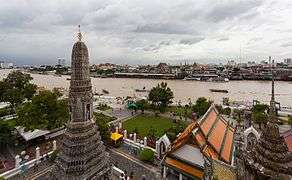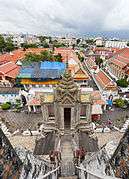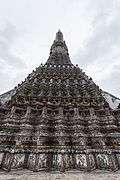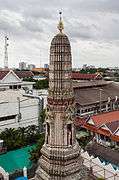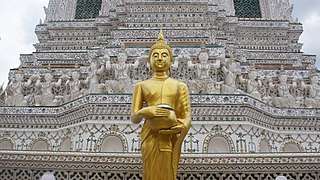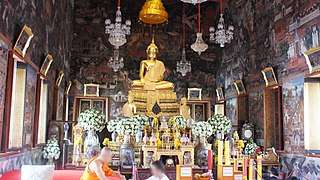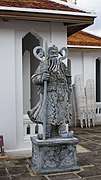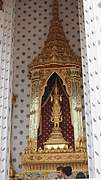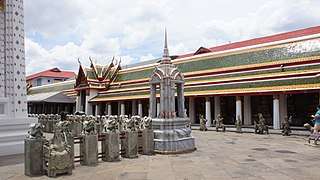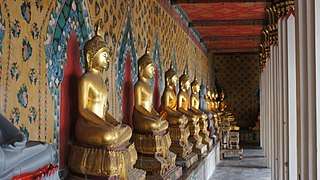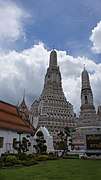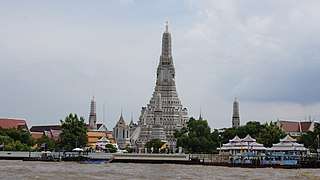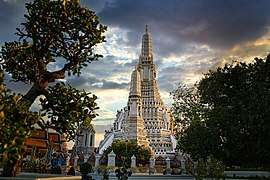Wat Arun
Wat Arun Ratchawararam Ratchawaramahawihan (Thai: วัดอรุณราชวราราม ราชวรมหาวิหาร ![]()
| Wat Arun Ratchawararam | |
|---|---|
Temple of Dawn | |
 Wat Arun at night, after the 2017 restoration | |
| Religion | |
| Affiliation | Theravada Buddhism |
| Location | |
| Country | Thailand |
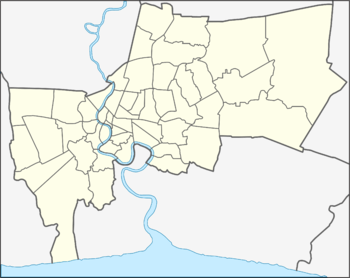 Location within Bangkok | |
| Geographic coordinates | 13°44′37″N 100°29′20″E |
| Architecture | |
| Completed | before 1656 CE |
| Website | |
| www | |
History
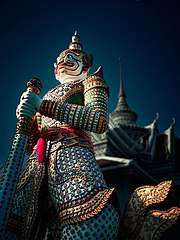
A Buddhist temple had existed at the site of Wat Arun since the time of the Ayutthaya Kingdom. It was then known as Wat Makok, after the village of Bang Makok in which it was situated. (Makok is the Thai name for the Spondias pinnata plant.) According to the historian Prince Damrong Rajanubhab, the temple was shown in French maps during the reign of King Narai (1656–1688). The temple was renamed Wat Chaeng by King Taksin when he established his new capital of Thonburi near the temple, following the fall of Ayutthaya.[3] It is believed that Taksin vowed to restore the temple after passing it at dawn. The temple enshrined the Emerald Buddha image before it was transferred to Wat Phra Kaew on the river's eastern bank in 1785.[4] The temple was located in grounds of the royal palace during Taksin's reign, before his successor, Rama I, moved the palace to the other side of the river.[2] It was abandoned for a long period of time, until the reign of King Rama II (1809–1824), who had the temple restored and the main pagoda raised to 70 m.[2] The work was finished during the reign of King Rama III (1824–1851).
The temple underwent major restorations during the reign of King Chulalongkorn (Rama V, 1868–1910) and in 1980, prior to the bicentenary celebration of Bangkok's foundation. The most extensive restoration work on the prang was undertaken from 2013 to 2017, during which a substantial number of broken tiles were replaced and lime plaster was used to re-finish many of the surfaces (replacing the cement used during earlier restorations). As the work neared its end in 2017, photographs of the results drew some criticism for the temple's new appearance, which seemed white-washed compared to its previous state. The Fine Arts Department defended the work, stating that it was carefully done to reflect the temple's original appearance.[5][6]
Architecture
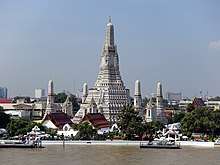
The main feature of Wat Arun is its central prang (Khmer-style tower) which is encrusted with colourful porcelain.[7] This is interpreted as a stupa-like pagoda encrusted with coloured faience.[8] The height is reported by different sources as between 66.8 m (219 ft) and 86 m (282 ft). The corners are surrounded by four smaller satellite prang. The prang are decorated by seashells and bits of porcelain which had previously been used as ballast by boats coming to Bangkok from China.[9]
The central prang is topped with a seven-pronged trident, referred to by many sources as the "Trident of Shiva".[10] Around the base of the prang are various figures of ancient Chinese soldiers and animals. Over the second terrace are four statues of the Hindu god Indra riding on Erawan.[11] In the Buddhist iconography, the central prang is considered to have three symbolic levels—base for Traiphum indicating all realms of existence, middle for Tavatimsa where all desires are gratified and top denoting Devaphum indicating six heavens within seven realms of happiness.[11] At the riverside are six pavilions (sala) in Chinese style. The pavilions are made of green granite and contain landing bridges.

Next to the prang is the Ordination Hall with a Niramitr Buddha image supposedly designed by King Rama II. The front entrance of the Ordination Hall has a roof with a central spire, decorated in coloured ceramic and stuccowork sheathed in coloured china. There are two demons, or temple guardian figures, in front.[11] The murals were created during the reign of Rama V.[11]
Cosmology
The central prang symbolises Mount Meru of the Hindu cosmology.[11] The satellite prang are devoted to the wind god, Phra Phai. The demons (yaksha) at the entranceway to the ubosot are from the Ramakien. The white figure is named Sahassa Deja and the green one is known as Thotsakan, the Demon Rāvana from Ramayana.
Travel
Wat Arun can be easily accessed through the Chao Phraya River, and ferries travel across the river towards the Maharaj pier. For foreigners, the temple charges an entrance fee of 50 baht (as of September 2019). During Kathina, the king travels to Wat Arun in a procession of royal barges to present new robes to the monks there.
Gallery
Notes
- Angova, Aneta. "Wat Arun - The Temple of Dawn". watarun.net.
- Liedtke 2011, p. 57
- ประวัติวัดอรุณราชวราราม ราชวรมหาวิหาร [History of Wat Arun]. watarun.org (in Thai). Retrieved 28 September 2012.
- Spooner 2011, p. 100
- Rojanaphruk, Pravit (19 August 2017). "New Dawn or Letdown? Iconic Temple Makeover Gets Mixed Reviews (Photos)". Khaosod English. Retrieved 7 September 2017.
- "Fine Arts stands by Wat Arun stupa repair effort". Bangkok Post. 17 August 2017. Retrieved 7 September 2017.
- Emmons 2008, p. 17
- Norwich 2001, p. 266
- Ridout 2009
- Wat Arun
- Emmons 2008, pp. 26-27
References
- Liedtke, Marcel (2011), Thailand- The East (English Edition), Norderstedt: Books on Demand GmbH, ISBN 978-3-8423-7029-6
- Spooner, Andrew; Borrowman, Hana; Baldwin, William (2011), Footprint Thailand, UK: footprintbooks.com, ISBN 978-1-904777-94-6
- Ridout, Lucy; Gray, Paul (2009), The Rough Guide to Thailand's Beaches & Islands, India: Rough Guides, ISBN 978-1-84836-091-4
- Norwich, John Julius (2001), Great architecture of the world, USA: De Capo Press Inc., ISBN 0-306-81042-5
- Emmons, Ron (2008), Top 10 Bangkok, New York: DK, ISBN 978-0-7566-8850-9
External links
| Wikimedia Commons has media related to Wat Arun. |
- Official website
- Panoramic view of the temple

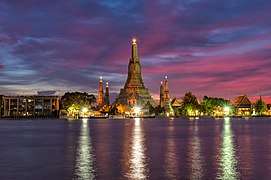
.jpg)


